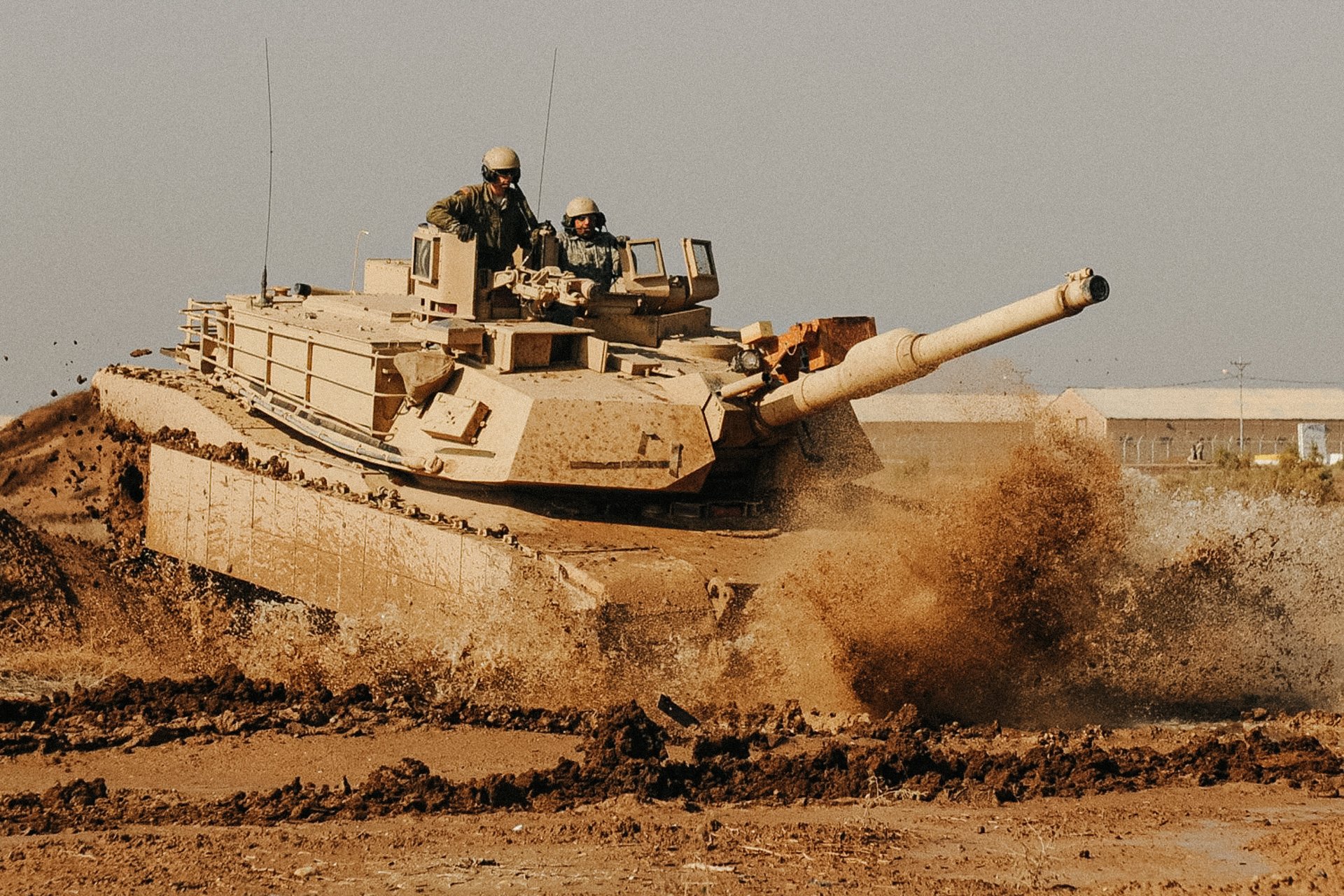
An Iraqi Army tanker with the 9th Armored Division drives an M1A1 Abrams tank under the instruction of soldiers with Company C, 1st Battalion, 18th Infantry Regiment, 2nd Advise and Assist Brigade, 1st Infantry Division, United States Division-Center Jan. 16, 2011, at Camp Taji, Iraq. US Army photo by Sgt. Chad Menegay.
The tank. Introduced alongside the first practical machine guns, chemical weapons, high-velocity artillery, and primitive aircraft, it changed warfare in ways the men who fought the American Revolution couldn’t have imagined. The concept has been refined and improved as mechanized warfare and the role of the tank has expanded and morphed. The result is the most fearsome land-based weapons platform known to man — the M1 Abrams third-generation battle tank.
According to the US Army’s Armor, 2019-2020, Training and Leader Development Strategy, “the fundamental mission of the tank platoon is to close with and destroy the enemy.” Since entering service in 1980, the M1 Abrams has certainly performed that mission. It has proven itself in multiple theaters, including the Persian Gulf and Afghanistan. More than that, it has completely dominated anything thrown its way.
Operation Desert Storm was arguably the first large-scale test for the US military’s then-new main battle tank. The M1 Abrams didn’t take long to prove itself; of the 2,000 tanks deployed for Desert Storm, not one was destroyed by enemy fire. During that same campaign, the M1 Abrams played a leading role in the Battle of 73 Easting, considered by many military historians to be one of the great 20th-century tank battles.
From the sands of Kuwait to the streets of Fallujah, generals, commanders, and support personnel have praised this tank. However, perhaps the most telling evidence of the Abrams’ success is its unprecedented longevity. Today, more than 40 years after it was introduced, this third-generation main battle tank is still the one to beat.
History of the M1 Abrams – Concept to Production
Named after US Army Gen. Creighton Williams Abrams Jr. — who commanded military operations in Vietnam and served as Army Chief of Staff from 1972 to 1974 — the M1 Abrams was designed by Chrysler Defense (which has since become General Dynamics Land Systems). It is a third-generation American main battle tank, designed for modern ground warfare.
Chrysler Defense was founded in 1940 for the massive buildup in production of tanks and other vehicles for Allies in World War II; it served as the dedicated tank-building division of Chrysler Motors. Its first facility, the Detroit Arsenal Plant, was initially created to build the Army’s M2 Medium Tank, which was abruptly declared obsolete before the factory even went online.
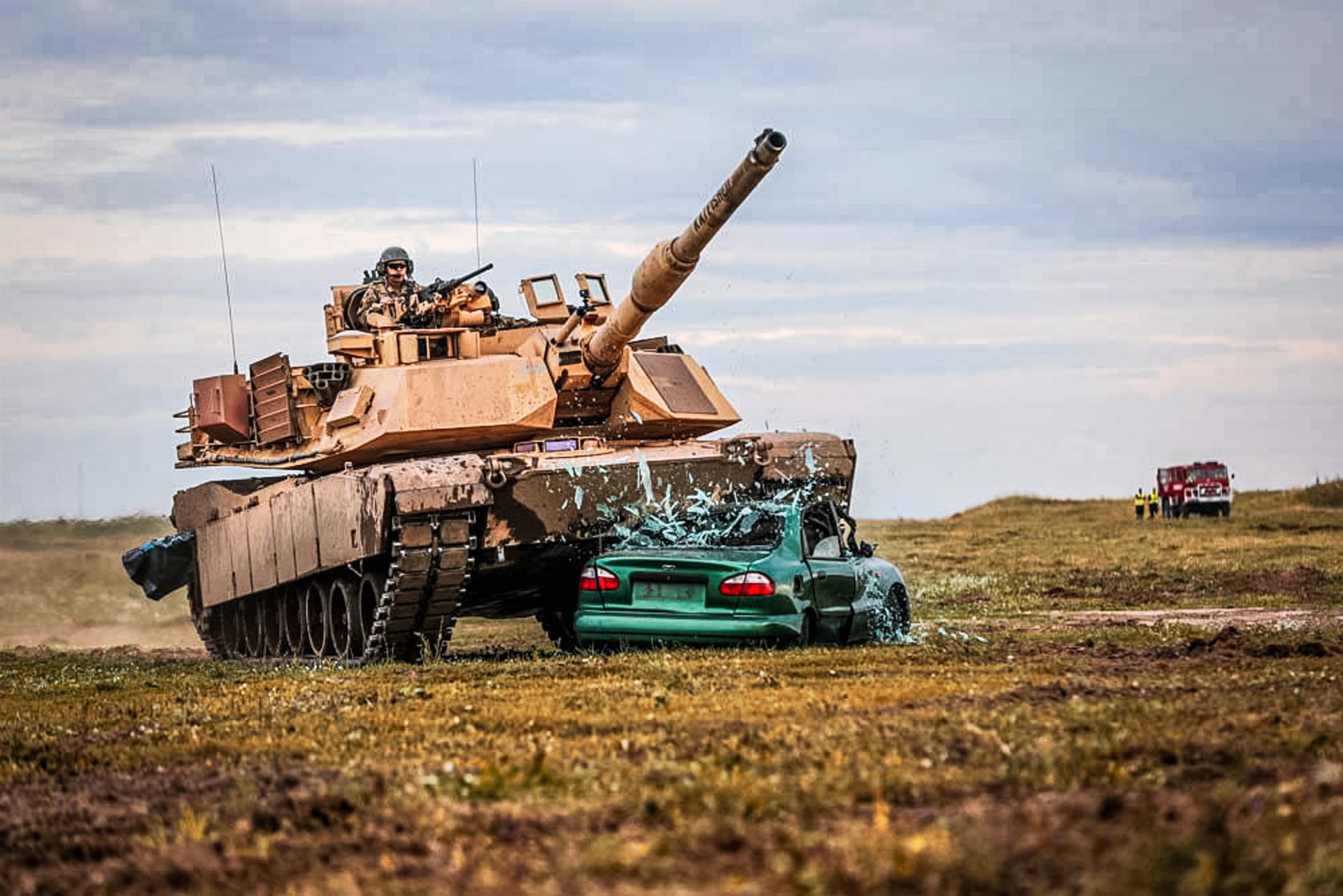
An M1 Abrams tank crushes a car during a simulated battle at Bemowo Piskie Training Area, Poland, July 13, 2019. US Army photo.
Chrysler worked with the military to change its plans, retooling the production line for the M3 Grant, a tank designed to support British forces during World War II before the US formally entered the conflict.
Throughout the 1960s, the US Army and Bundeswehr (German military) were involved in a joint project to replace the aging American M60 and German Leopard 1 Cold War–era tanks. The resulting design, dubbed the MBT-70, ultimately failed to meet expectations. The MBT-70 was suspended in 1969, largely due to budget concerns, and was officially scrapped two years later.
In 1973, Chrysler Defense and General Motors submitted competing prototypes for the Army’s new tank. After more than three years of deliberations, it seemed all but certain that the Defense Department would award the contract to GM.
But at the last minute, an internal disagreement within the United States military erupted over the tank's proposed power plant. High-level research and development personnel favored Chrysler’s gas turbine engine design. On Nov. 12, 1976, the contract was awarded to Chrysler Defense.
Operational Versions
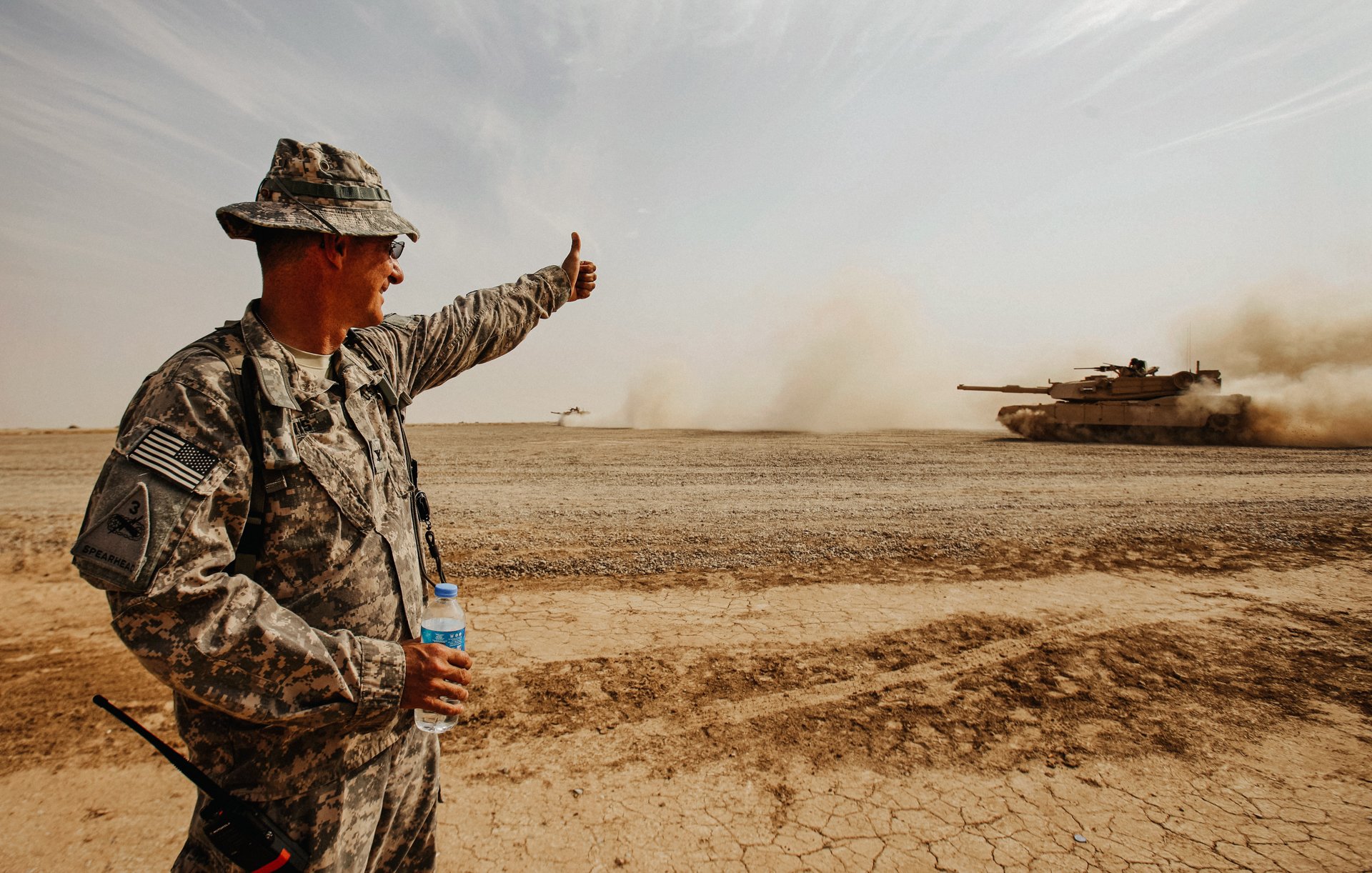
A US Army soldier gestures to Iraqi army soldiers aboard an M1A1 Abrams tank, purchased from the US, during a training exercise outside Baghdad, Iraq, Tuesday, Oct. 18, 2011. AP photo by Khalid Mohammed.
Since the introduction of the M1 Abrams in 1980, two newer versions have been produced — the M1A1 Abrams in 1985 and the M1A2 Abrams a few years later. Each version brought significant improvements to weaponry, armor protection, and electronics.
The most notable change to the M1A1 was the upgraded main gun. The M1A2 included new armor fortified with depleted uranium, as well as a major technology overhaul for the command and control systems.
Both of these subsequent operational versions received additional iterative improvements, referred to as System Enhancement Packages, or SEPs. The first one was a Situational Awareness (SA) upgrade for the M1A1, adding a forward-looking infrared (FLIR) sight, powertrain improvements, and “Blue Force” tracking system that identified the tank’s location relative to friendly forces.
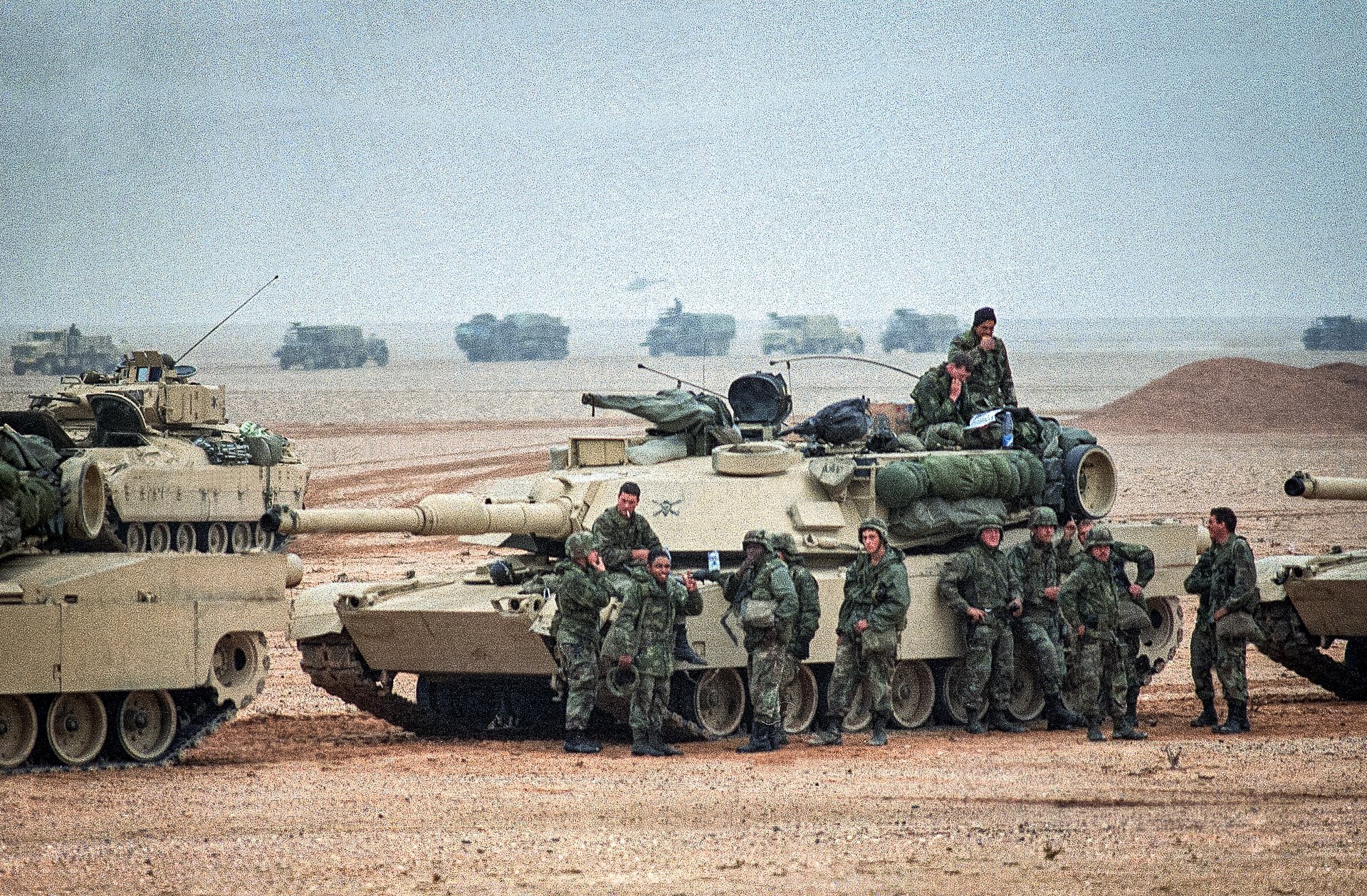
Troops from the Army’s 1st Infantry Division lean on an M1A1 Abrams main battle tank as a convoy passes in the background at an assembly point in the afternoon on Sunday, Jan. 21, 1991, in Saudi Arabia. Troops from the 1st Infantry Division have taken up positions close to the border with Kuwait. AP photo by Peter DeJong.
Likewise, the M1A2 has seen two SEP refinements:
- SEPv2 upgraded the tank’s command and control electronics to a digital architecture and provided the gunner and commander their own, independently operated sights. The new sights allowed the gunner to engage a target while the commander located the next.
- SEPv3 rectified many of the space, weight, and power challenges identified during Operation Iraqi Freedom and employed an ongoing list of technology enhancements to improve power management and overall survivability in the field.
An SEPv4 package is now in the works, promising an updated 3GEN FLIR sight and more advanced laser targeting capabilities.
While the major operational versions and iterative enhancement packages made the M1 Abrams tank stronger and more lethal, improvements to the armor have gradually increased the overall weight of the tank. The latest M1A2 model is among the heaviest combat armored vehicles in the world, weighing in at 73.6 tons. It’s also among the most expensive, with a vehicle sticker price north of $10 million.
According to Radio Free Europe and Radio Liberty, the US Army is believed to have 2,509 Abrams tanks of various operational versions, with an additional 3,700 in storage.

Somali children run alongside a US Marine M1 Abrams tank during an armored patrol in north Mogadishu, Somalia, Tuesday, Jan. 26, 1993. AP photo by Mark Duncan.
Characteristics and Specifications
All variants of the M1 Abrams tank have a crew compartment that accommodates four soldiers: a commander, a driver, a gunner, and an ammunition loader. The driver pilots the tank from the front, inside the hull, while the commander occupies a standing position, inside the rotating turret. The gunner sits at the commander’s feet, with the loader positioned to the left of the gunner near the cannon’s breech.
Drivetrain
Despite its massive size and weight, the innovative engine and drivetrain make this tank amazingly maneuverable. The M1 Abrams is fully tracked, with a caterpillar-style design consisting of steel plates stitched together with chain mail. The tread belts are wrapped around a drive sprocket and seven road wheels on each side of the hull. The sprockets are the only wheels that are directly connected to power.
The M1 Abrams is powered by a Honeywell AGT1500 engine, which can burn multiple types of fuel, including diesel, jet fuel, gasoline, and marine diesel. The AGT1500 uses a turbine rather than conventional pistons.
Unlike a typical piston-driven diesel motor, the gas turbine design requires no warm-up period or cooling system. It also has fewer moving parts than conventional designs, making it comparatively easy to service and maintain.
Engine output is rated at 1,500 horsepower, with 2,750 ft-lb of torque. If these numbers don’t mean anything to you, just know the AGT1500 is a friggin’ beast.
Depending upon the operational version, the M1 Abrams is capable of speeds up to 45 mph. The tank can travel 265 miles on its 500-gallon maximum fuel capacity.
Heavy Armor
As previously noted, the Abrams’ armor has evolved over the years. The most current M1A2 version is protected by composite Chobham armor, which incorporates various layers of steel, ceramic, Kevlar, and depleted uranium. We could tell you more but then we’d have to kill you — details of the construction are classified. Suffice to say it’s designed to withstand impact from the latest high-energy anti-tank weaponry.
In addition, the newest operational versions of the M1 Abrams tank can be fitted with up to 30 tiles of explosive reactive armor, or ERA. These tiles are designed to purposely detonate when hit by enemy fire, creating opposing kinetic energy that effectively cancels out the destructive energy of the incoming round.
Armament
The primary weapon on M1A1 and newer versions of the Abrams tank is a 120mm M256 smooth-bore cannon. The M256 is the American spinoff of the German Rheinmetall RH120mm L44. It’s a high-velocity, deadly accurate weapon used for eliminating enemy tanks and other hard targets.
This cannon has a maximum effective range of 3,280 yards (3,000 meters) and can fire a variety of projectiles, many of which are designed to pierce armor.
Secondary weapons include a .50-caliber CROWS system and two 7.72mm M240 machine guns. The CROWS — Common Remotely Operated Weapon Station — allows the tank commander to directly operate a mounted M2 .50-cal. machine gun or fire it remotely from inside the turret.
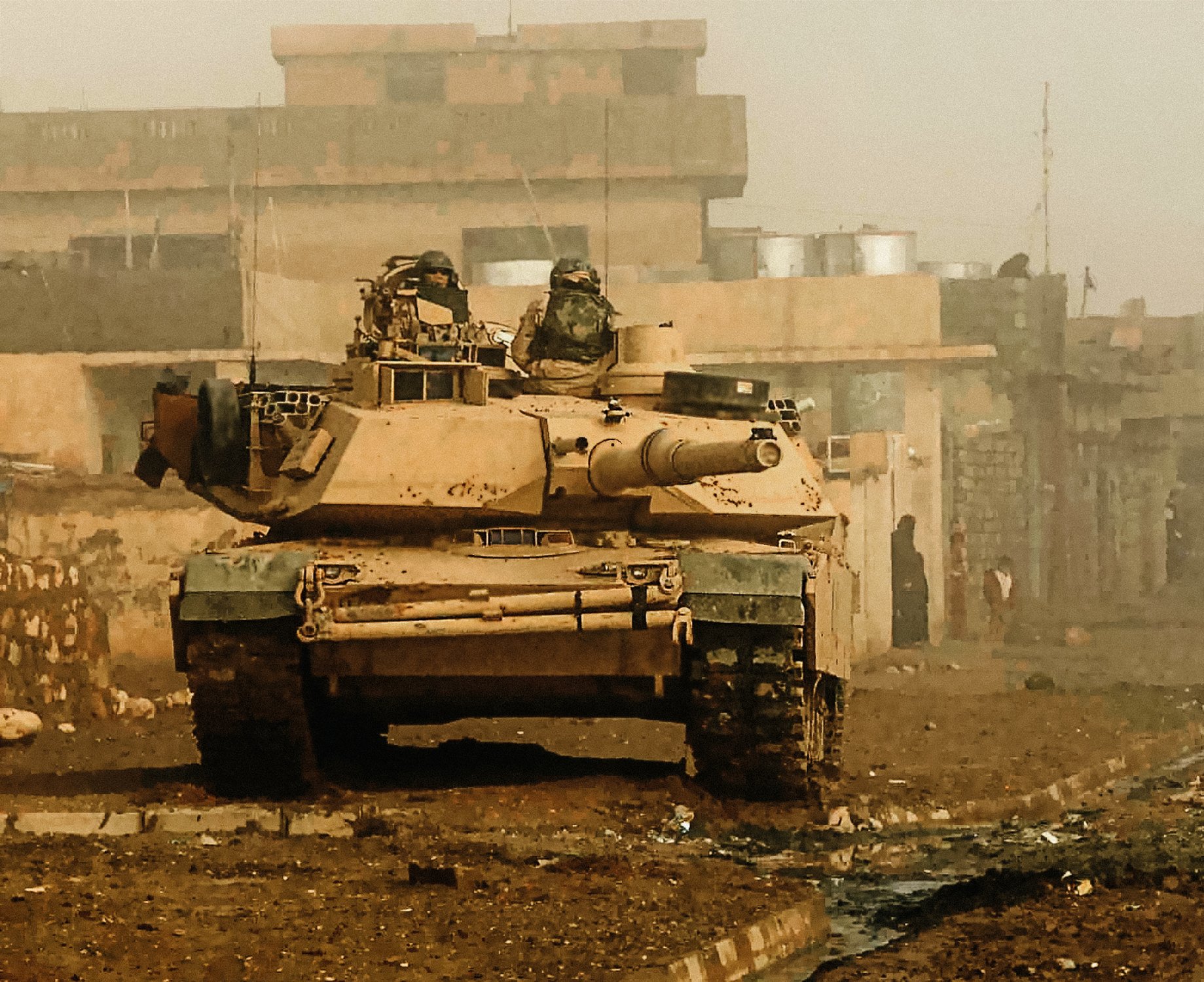
US soldiers from 3rd Armored Cavalry Regiment in an M1 Abrams main battle tank in Biaj, Iraq, in May 2008. US Army photo by Staff Sgt. Aaron Allmon II.
The system has two main components: the mount and the control group.
- The mount supports the gun and is bolted to the exterior, directly in front of the commander. It’s gyro-stabilized, rotates a full 360 degrees, and is capable of −20 to +60 degrees of elevation. The sight package includes a daylight videocamera, a thermal camera for nighttime engagements, and an eye-safe laser rangefinder.
- The control group mounts inside the turret. It includes a display, switches, and joystick to remotely acquire and engage targets.
One of the two M240 machine guns serves as a coaxial weapon for the tank gunner. The point of aim is tied directly to that of the M256 cannon. Anywhere the primary gun points, the coaxial gun points as well.
Based upon the target, the gunner can choose which one to fire. For example, infantry formations would not be an appropriate target for expending cannon rounds.
The other M240 is available for the ammunition loader to assist with unarmored target engagement as needed. This weapon must be directly controlled — there is no remote control capability from below.
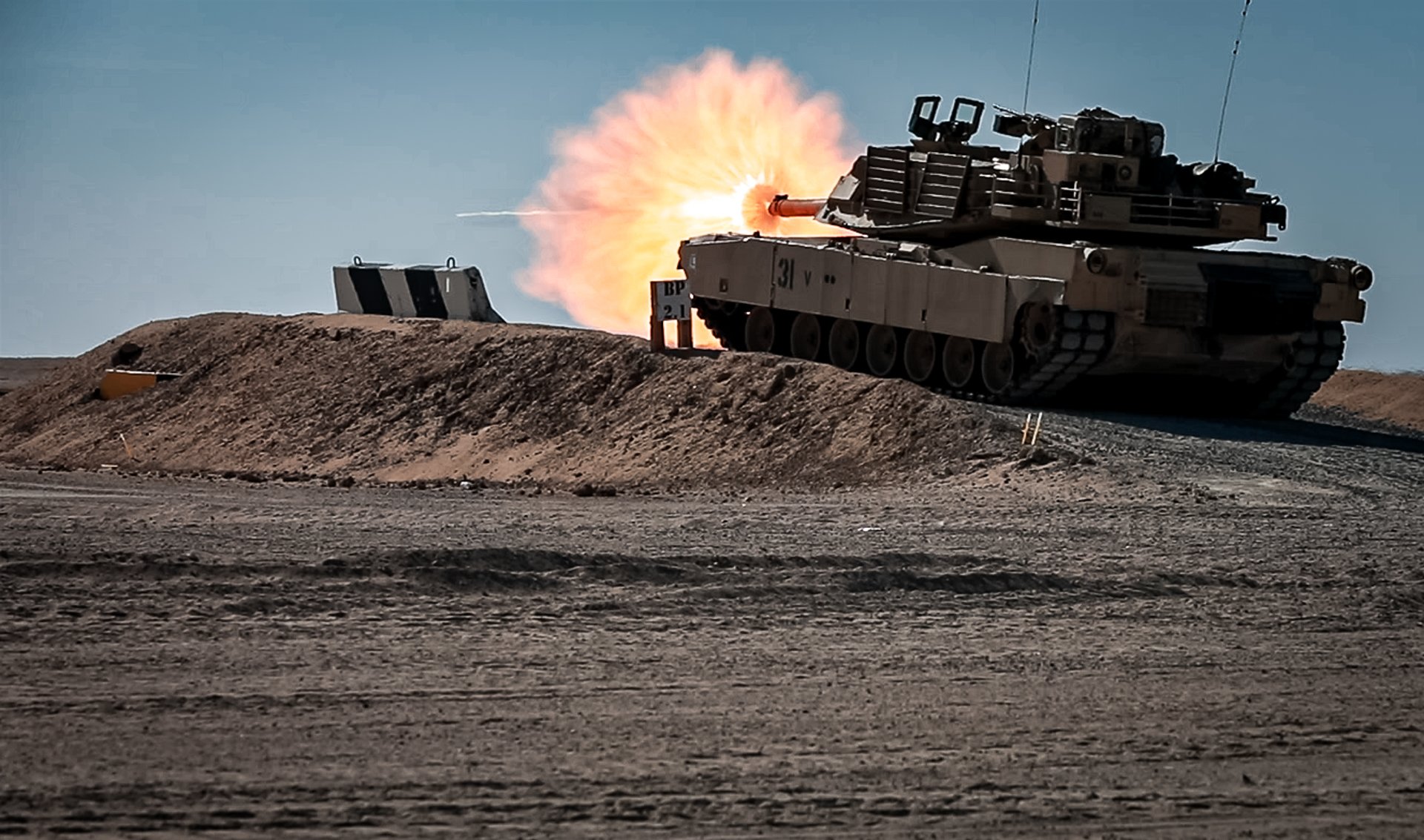
US Army soldiers conduct live-fire training in the M1A2 Abrams Main Battle Tank at a targeting range in the US Central Command region on Jan. 28, 2020. US Army photo by Spc. Ryan Swanson.
What’s Next for the M1 Abrams?
In January 2023, six months after providing American-made Javelin anti-tank weapons to Ukraine, the Biden administration announced it would be sending nearly a full battalion of M1 Abrams tanks to the Ukrainian war zone as well. At that time, Defense Department officials said it would take a full year to fulfill that commitment.
However, in March, the Pentagon followed up with a second announcement, indicating the tanks would be delivered sooner — as early as fall 2023. The revised plan involves substituting the older M1A1 model for the M1A2s that were initially specified.
In addition to shaving time off the delivery schedule, the Defense Department suggested the M1A1 has a friendlier learning curve and will be easier to maintain than the newer version.
Read Next: Russian Businesses Offer Bounty for Destroyed Abrams Tanks

Tim Cooper is a contributing writer for Coffee or Die and has been a freelance writer for more than 20 years. He is also a certified firearms instructor and soon-to-be-famous recording artist with Fat Chance Records. When Tim is not traveling the world on assignment, which is actually more often than not, you will probably find him at a nearby shooting range or sitting behind a drum kit, staring at his bandmates in bewilderment.
BRCC and Bad Moon Print Press team up for an exclusive, limited-edition T-shirt design!
BRCC partners with Team Room Design for an exclusive T-shirt release!
Thirty Seconds Out has partnered with BRCC for an exclusive shirt design invoking the God of Winter.
Lucas O'Hara of Grizzly Forge has teamed up with BRCC for a badass, exclusive Shirt Club T-shirt design featuring his most popular knife and tiomahawk.
Coffee or Die sits down with one of the graphic designers behind Black Rifle Coffee's signature look and vibe.
Biden will award the Medal of Honor to a Vietnam War Army helicopter pilot who risked his life to save a reconnaissance team from almost certain death.
Ever wonder how much Jack Mandaville would f*ck sh*t up if he went back in time? The American Revolution didn't even see him coming.
A nearly 200-year-old West Point time capsule that at first appeared to yield little more than dust contains hidden treasure, the US Military Academy said.












